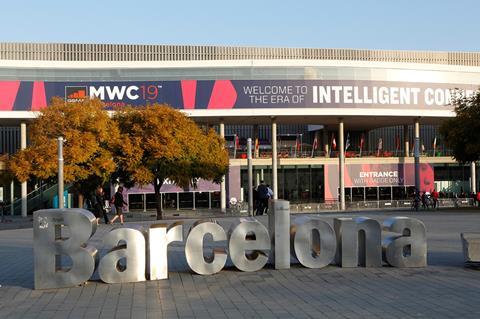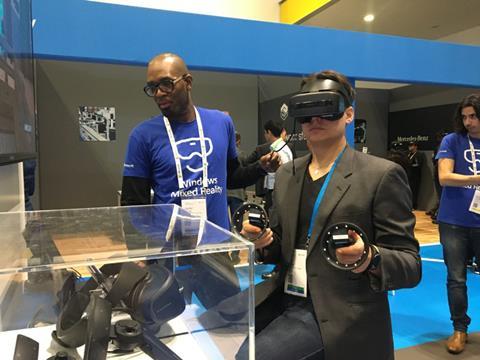From foldable phones to live biohack chip implants and an exhibition and conference awash with 5G, we look at the likely trends and talking points at this year’s Mobile World Congress.
With global sales of smartphones stalling for the first time last year, manufacturers will be looking to restoke the market with innovations including foldable designs, multiple cameras and artificial intelligence at Mobile World Congress in Barcelona.

The 1.43 billion handset sales made globally in 2018 was 5% fewer than in 2017, according to Strategy Analytics. Market leader Samsung’s sales dropped 26 million to 291.3 million in 2018 and Apple’s 206.3 million units were also several million down on 2017. Meanwhile, Chinese brands Huawei and Xiaomi grew in size with Huawei predicted by Strategy Analytics to overtake Apple in phone sales by the end of this year. Huawei is sending its Chairman, Guo Ping, to talk up the company at MWC and talk down the threat certain governments claims it poses to national networks.
Handset innovation
After the smartphone and the tablet (and the phablet) comes a new gadget that can transition between a phone and a tablet which handset makers hope will become the next must-have accessory.
Samsung previewed a version of Galaxy last November sporting a 4.5-inch screen that opens up to a 7.3-inch screen. The display is built from a composite polymer technology called Infinity Flex that Samsung said is capable of being folded “hundreds of thousands of times” without breaking.
The Samsung Galaxy Fold launched yesterday, costing nearly $2,000 and protracts from 4.3 inches into a 7.3 inch tablet. It has been characterised as a solution to a problem that doesn’t exist.
Samsung also launched the latest Galaxy flagship S10. In fact there are four new S10s. Three of them feature three rear cameras that allow for wider-angle photos. The fourth is Samsung S10 5G, the first of an expected deluge of phones to be equipped for the super-fast fifth generation network.
The #GalaxyS10 is a next generation smartphone like no other.
— Samsung Mobile (@SamsungMobile) February 20, 2019
The next generation Galaxy has arrived.
Learn more: https://t.co/UstjA79jjF pic.twitter.com/IWbJ039quG
Samsung was beaten to the punch by Chinese maker Royole which launched the FlexPai last December. This transforms from a conventionally sized handset into a 7.8-inch tablet capable of withstanding 200,000 folds. That’s the equivalent of opening or closing the phone 548 times a day for a year or 274 times a day for two years, calculates CNET. Xaomi has also teased a foldable design and Huawei, LG and Motorola aren’t far behind.
Among the technical challenges facing origami phone designs: making it thin enough to fit into your pocket; durability, particularly down the ‘seam’ where the folding happens; and overcoming the ‘cheaper’ experience of swiping plastic rather than glass (although manufacturer Corning has a flexible glass in the works).
The biggest issue could be making a commercial case. Some consumers would appreciate packing one rather than two screens to watch a show on the way to work and may be prepared to spend the expected €1300 prices to do so.
“Unless the foldable device is supported by [a] solid operating system and software support, a foldable phone risks going into history as a gimmick,” warned Gartner analyst Werner Goertz.

Another smartphone selling point is the sophistication of its camera. The LG V40 ThinQ, which launched late last year, contains five cameras for capturing five different perspectives including telephoto, a super-wide-angle camera and lenses for selfies and group selfies. It has even applied for a 16-lens design patent.
At MWC, expect Nokia to debut the Nokia 9 Pureview which also contains five cameras. More sensors look good, as does greater resolution with 40 megapixels no longer uncommon, but it’s the phone’s software which improves its versatility. Huawei’s flagship P20 Pro, for example, carries three Leica cameras and features a ‘gradient’ colour finish, that shifts colour in different light. It is expected to better this at MWC with debut of the P30.
Information from multiple sensors can be combined to produce decent images in low light conditions while AI systems can automatically adjust the picture’s colour saturation or depth of field by recognising the object in the frame.
5G phones
Following yesterday’s launch of Samsung’s S10, 5G is expected to dominate the premieres of more 5G-enabled handsets from the likes of LG, OnePlus and Huawei. Buying one would be the equivalent of having an 8K TV; networks are limited to a few urban areas with few applications available to take advantage of its multi-gigabit two-way connectivity.
The 855 does however have a built-in 4G LTE modem capable of connecting at speeds of up to 2Gbps which is way more than most people need today.
Most 5G Android phones will be powered by the latest Snapdragon 855 chipset. Qualcomm claims the chip will provide “blazing-fast responsiveness and unprecedented speeds previously unachievable in mobile communication.”
The chip can compute more than 7 trillion operations per second with computer vision and neural network capabilities to support the surge of AI voice, gaming and extended reality experiences over 5G networks. It will also support video recording using HDR10+ and can identify and display than one billion shades of colour. The chip is future-proofed to enable ‘volumetric’ (3D) virtual reality at 8K resolution, such as the world’s first application being developed by Japanese telco NTT DOCOMO.
Hololens 2
There are those who think that the smartphones days have peaked and that its functions will instead morph into wearable computing products such as smart fabrics and mixed reality line of sight devices such as Magic Leap and Microsoft Hololens. Both of these companies feature at MWC.

Microsoft is promising a big announcement on the eve of the show, widely predicated to be the release of the second version of its augmented-reality glasses. HoloLens 2 will likely include Qualcomm’s Snapdragon instead of an Intel chipset, improved field of vision, a lighter weight for greater comfort and a version of Windows 10 designed for Mixed Reality experiences. The firm is sending its CEO Satya Nadella to present. Meanwhile, Omar Khan the chief product officer of rival Magic Leap will give an update of its mixed reality concept.
The ultimate wearable is of course a chip implanted in your body, interacting with your nervous system or monitoring bodily functions. So called biohacking is a fashion among the rich digerati of Silicon Valley but there’s also an intriguing session at MWC which promises to implant a chip into someone – live. On the panel is Edgar Pons ‘technology lover and industrial engineer’ who also helps ‘optimise livestock production’ by automating the weighing and taking of biological data of animals “in an unprecedented fashion”.
5G deployment
This is the year that 5G will officially move from hype to deployment cycle and expectations of 5G are high. Many assume it will deliver a transformative promised land – an improved end-user experience, new applications, new business models and new services riding swiftly on the back of gigabit speeds, improved network performance and reliability.
Rollout will be the talking point of the show. However, despite the potential benefits, there is concern that 5G is premature and notes of caution are being sounded. Operators are sceptical about the commercial case given the high-levels of in- vestment needed to deploy 5G networks. Ericsson estimates the cost to deploy a small cell-ready 5G network can range from U$6.8 million for a small city to U$55.5 million for a large, dense city. Those figures assume that fibre backhaul is commercially feasible.
“A viable case for investment in 5G can be made for densely populated urban areas – always the most commercially attractive regions for operators,” Ericsson states. “More challenging will be a commercial argument for investing in 5G networks outside such areas, especially in the early years of 5G deployment.”
As a result, the operator warns, rural and suburban areas are less likely to enjoy 5G investment, and this will potentially widen the digital divide.

The stage is set for a number of major mobile service providers to expand their video ambitions—an effort that will likely dovetail with their respective 5G network strategies. For example, T-Mobile offers Netflix with its mobile service plans and could go further through its acquisition of Layer3 TV. T-Mobile is bundling Hulu with its services and BT has just launched a consumer OTT app that will allow BT Sport subscribers to watch its channels and content on internet-connected TVs and video game platforms.
The biggest bet is being placed by AT&T on the back of DirecTV and Time Warner acquisitions. It already streams HBO Now and DirecTV Now and will shortly launch another direct-to-consumer SVOD service built on Warner’s content.
Intelligent everything
Beyond video there’s another trend which will gain momentum this year.
The GSMA has called it the era of ‘Intelligent Connectivity’, the combination of endless connectivity enabled through 5G and the Internet of Things.
With the market for mobile phones saturated in many markets, operators spy growth in connecting things like watches, cars and street lights.
AT&T, for example, has the most number of connected cars “in the history of the industry” at 27 million, according to research firm Chetan Sharma Consulting in its Q3 2018 report for the US.
The IoT is an opportunity that operators are clearly chasing. Verizon, AT&T and T-Mobile are all implementing network technologies like NB-IoT and LTE M that are designed to power smaller, inexpensive gadgets like watches and other devices.
Facebook, Amazon and Google are in town with an eye on connectivity via social media and voice-activation.
Among the more exotic show launches is an AI-enabled robotic lawnmower. Its maker, garden machinery maker Husqvarna, will speak about a new era “where outdoor robots and people work in symbiosis to deliver smart cities and smart gardens.”
Saving the world
“We are on the cusp of the 5G era, which will spark exciting new possibilities for consumers and promises to transform the shape of virtually every business,” said Mats Granryd, director general of mobile operator’s lobby group GSMA.
He can point to a demo at MWC which promises the first live over 5G remote tele-surgery. A specialist surgeon will be at the MWC auditorium “guiding surgeons in the operating room of a remote hospital in real time”. Actually, not that remote since the hospital will be in Barcelona, but impressive none the less.
The GSMA is a highly influential body, keen to promote the interests of its mobile operator shareholders as pivotal to global prosperity and even to lifting millions of people in developing nations out of poverty.
At the World Economic Forum in Davos last month the GSMA launched a Digital Declaration signed by companies like China Mobile, Sony Telefónica, Turkcell and Deutsche Telekom, which called on businesses to mitigate “social, technological, political and economic” disruption as more and more of the world’s economy relies on going digital.
It’s in mobile operator’s interests to ensure that cyber-security and privacy rules are upheld so that consumers don’t lose trust in sharing their data over the internet and also to encourage governments to make mobile connectivity a focus of national investment.
Lending weight to its argument, the event has attracted political heavyweights including EU digital commissioner Mariya Gabriel, the African Union Commission’s head of energy and infrastructure Dr Amani Abouzeid, Red Cross president Francesco Rocca, and one of the most powerful women in all government, the UN deputy secretary general Amina Mohammed.
























No comments yet